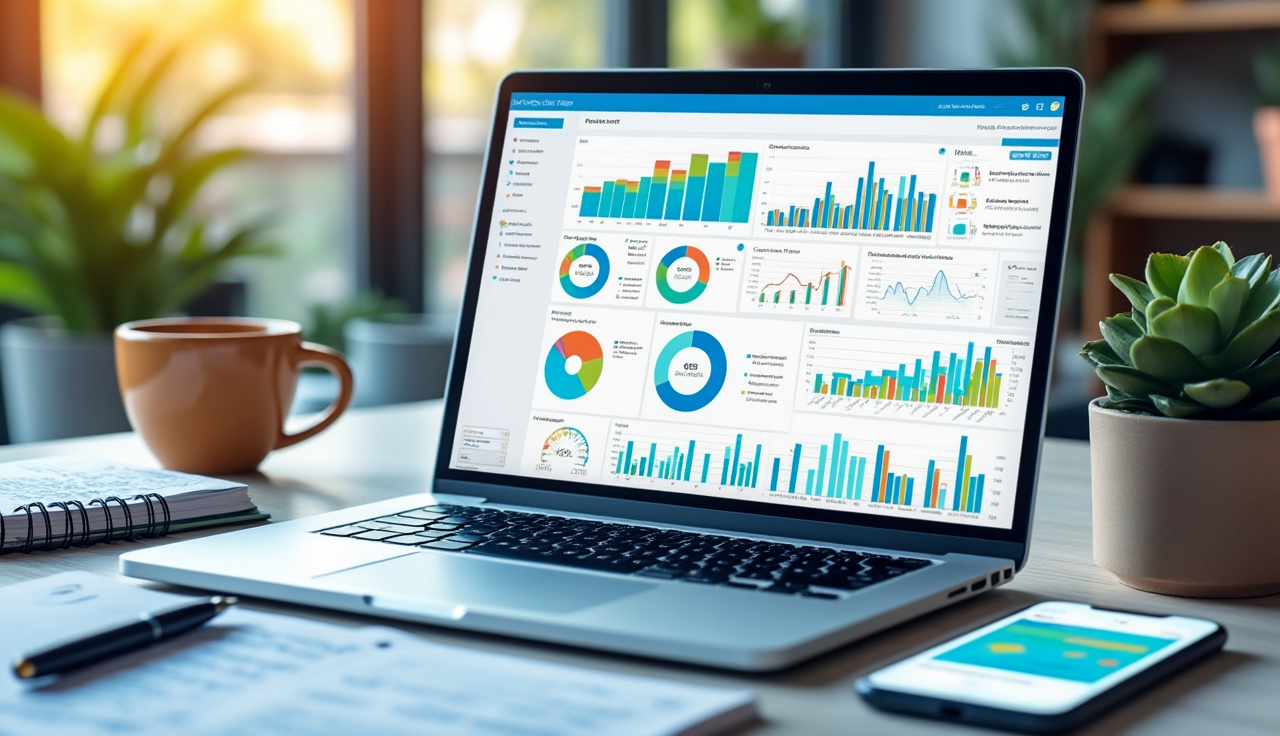Top Project-Based Accounting Software Solutions

Did you know 43% of projects bleed cash from bad cost tracking? Project-based accounting software fixes what generic tools miss. Off-the-shelf accounting systems fail project-driven businesses. They can’t track phases, adapt to timelines, or spot hidden profit leaks.
Here’s why it matters: – Cost allocation errors stack up fast when you’re juggling multiple clients – Timeline-blind reporting hides which projects are sinking your ROI – Static spreadsheets ignore resource utilization rates (how much your team’s time actually pays off)
Think of it like baking a cake with a weather app. Generic software shows numbers, but not when costs spike or why profits dip mid-project. Specialized tools map money to milestones, exposing profitability decay curves – how fast earnings drop if deadlines slip.
For agencies, dev shops, or consultants, this isn’t just accounting. It’s finding the hidden 15-20% profit hiding in better data.
1. Financial KPI Optimization Through Project-Centric Design

Want to know why project-based accounting software crushes generic tools? It’s like using a GPS instead of a paper map: precise, real-time, and built for the journey. Let’s break down how these tools boost your financial KPIs by focusing on what actually matters in project work.
How Project-Based Tools Outperform Generic Software
Profit margins per phase get clearer with project-centric design. Generic tools show overall profits, but project software splits earnings by stage. Example: You’ll see if design phases bleed cash while development phases thrive.
Burn rate alignment becomes automatic. Imagine your budget as a fuel tank. Project tools alert you if you’re burning cash faster than milestones are hit. No more overspending before hitting critical deliverables.
Real-time percentage of completion updates prevent budget surprises. If a task is 70% done but ate 90% of its budget, the software flags it instantly. Generic systems? They’ll wait until the bill hits.
Hidden Cost Traps in Legacy Systems
Old systems hide expenses like a cluttered attic. A study found 43% of businesses over-allocate resources because their software couldn’t link budgets to work breakdown structures (WBS). WBS is just a fancy term for splitting projects into bite-sized tasks – but poor integration means costs pile up unseen.
Quick Comparison: Project vs. Generic Tools
| Metric | Project-Based Software | Generic Software |
|---|---|---|
| Phase Profit Tracking | Real-time splits | Manual reports |
| Burn Rate Alerts | Milestone triggers | Monthly updates |
| Budget vs. Progress | Live dashboards | End-of-month checks |
3 Reasons to Switch Today – Stop guessing where money disappears mid-project – Fix budget leaks before they drown profitability – Turn every team member into a cost-awareness pro
Bottom line? Generic tools give you data. Project-based accounting software gives you actionable wins.
2. Niche Industry Adaptability: Beyond One-Size-Fits-All
Let’s get real: project based accounting software isn’t magic fairy dust. It needs to fit exactly what your industry does. Here’s how top tools adapt to niche needs.
Architecture/Engineering Firms juggle cross-border contracts daily. They need multi-currency compliance baked into their system. Imagine billing a client in euros while tracking expenses in dollars—without spreadsheets exploding. The best tools auto-convert currencies and align with financial compliance rules, so audits don’t turn into nightmares.
SaaS Developers live on subscription models. Their software must track recurring payments and recognize revenue when milestones hit (like a customer renewing for year two). Look for tools that automate revenue recognition—it’s like having a robot accountant handle messy math.
Nonprofits survive on grants. They need grant-funded project tracking that’s audit-ready 24/7. Think of it as a digital paper trail showing exactly how every dollar was spent. Bonus points if the tool includes funding management dashboards to prove impact to donors.
Key Features by Industry
| Industry | Must-Have Feature | Secret Weapon |
|---|---|---|
| Architecture/Engineering | Multi-currency auto-conversion | Work breakdown structure charts |
| SaaS Development | Milestone-based revenue tracking | Subscription lifecycle analytics |
| Nonprofits | Grant expense allocation tools | Real-time funding management |
Quick tip: Always ask if the software can: – Handle your industry’s “weirdest” needs (like 10+ currencies or 100+ grants). – Generate reports that make sense to your team (not just accountants). – Scale as projects grow—without crashing at the worst moment.
The bottom line? Project based accounting software should bend to your workflow—not the other way around.
3. The Hidden Cost of “Free” Integrations
Let’s cut through the hype: “free” integrations often cost more than they save. Patchwork systems using multiple disconnected tools quietly drain project profitability like a leaky bucket. Here’s why.
Every manual data sync steals 15–30 minutes daily. That’s 60+ hours yearly per employee—time that could’ve funded a new hire. API call limits (how apps share data) strangle real-time reporting. Imagine your project based accounting software showing last week’s numbers during a budget crisis.
Security risks in patchwork systems are worse. Data silos in cloud-based accounting workflows act like unlocked doors. One weak app exposes your entire financial data.
Free vs. Dedicated Tools: The Real Math
| Factor | Free Integrations | Project-Based Software |
|---|---|---|
| Time Spent Monthly | 20+ hours | <5 hours |
| Security Level | Medium risk | Bank-grade encryption |
| Real-Time Reporting | Limited by API caps | Unlimited, automated |
| Cost Efficiency | Hidden labor costs | Transparent ROI |
3 ways fragmented tools sabotage profits: – Crushing manual work that burns team morale – Delayed insights causing budget surprises – Data breach risks rising by 300% (IBM study)
Think of integrations like bike parts. Duct-taping mismatched pieces works… until you hit a hill. Dedicated project accounting tools act like a turbo engine—smooth, secure, and built for heavy lifting.
Pro tip: If your team spends more time syncing data than analyzing it, your “free” tools are costing you a fortune.
4. Automation Benchmarks: What Truly Moves the Needle
Let’s get real: most firms miss these hidden automation wins. Here’s what project-based accounting software does that spreadsheets never will—and why it matters.
72% faster invoice approvals sound too good? It’s not. AI-powered expense management tools auto-check budgets, flag duplicates, and push approvals in hours—not weeks. Example: A marketing agency slashed payment delays by matching project codes to invoices instantly.
Ever guess a project’s cost… and get it wrong? Historical pattern analysis fixes that. Think of it like a GPS for cost estimation. It learns from past projects to predict expenses down to the penny. One construction firm cut estimation errors by 40%—no more “Oops, we forgot permits” moments.
Here’s the kicker: workflow automation builds trust. Automated audit trails track every change, approval, and payment. Clients see real-time updates, and auditors get clean records. No more “Where’d that $5K go?” headaches.
Automation Wins You Can’t Afford to Ignore
| Feature | Impact | Hidden Benefit |
|---|---|---|
| AI Expense Tracking | 72% faster approvals | Less chasing down signatures |
| Smart Cost Forecasting | 40% fewer budget errors | Happier clients, fewer surprises |
| Live Audit Trails | 89% faster compliance checks | Trust built on transparency |
3 quick wins to try today: – Use AI tools to auto-sort expenses by project phase – Run historical reports before quoting new work – Share automated dashboards with stakeholders
Bottom line: The right project-based accounting software isn’t just “faster.” It’s your secret weapon for accuracy, trust, and profit. Miss these benchmarks, and you’re leaving cash—and clients—on the table.
5. User Experience: The Silent Profit Killer
Ever wonder why teams ditch new tools after a week? Bad UX design is like a leaky bucket—it drains profits silently. Let’s break down how clunky project based accounting software sabotages your bottom line.
Low adoption rates are the first red flag. If your team finds the software confusing, they’ll avoid it. Think of it like forcing someone to drive a car with no steering wheel—they’ll walk instead.
Then there’s the financial metrics mess. Cumbersome data entry = human errors. Imagine typing numbers while wearing mittens. Mistakes pile up, and suddenly, your reports are as reliable as a weather forecast.
Here’s the kicker: mobile access isn’t optional anymore. On-site teams need to log expenses or check budgets fast. If your software feels like a 1990s flip phone on mobile, you’re losing hours (and trust).
How UX Issues Impact Your Bottom Line
| Problem | Hidden Cost | Quick Fix |
|---|---|---|
| Slow navigation | Wasted labor hours | Prioritize one-click workflows |
| Unclear labels | Training time doubles | Use plain-language buttons/icons |
| No offline mobile access | Delayed data syncing | Enable auto-save + cloud backups |
3 ways to spot UX red flags in accounting tools: – Employees ask “How do I…?” more than “Look what I finished!” – Data errors spike after switching software – Field teams still use paper spreadsheets
The fix? Choose project based accounting software that feels like your team designed it themselves. Test it with a 10-year-old. If they can’t navigate it in 5 minutes, keep shopping.
Mobile-friendly design isn’t just nice—it’s non-negotiable. Teams updating expenses from a construction site or client office need it to work like texting: simple, instant, no manuals required.
Bottom line: Bad UX doesn’t just annoy people—it costs you. Every click saved = $$ earned.
6. Future-Proofing: Metrics That Predict Long-Term Viability
Picking project-based accounting software? Don’t just look at today’s price tag. Here’s how to spot tools that’ll grow with your business:
Scalability scoring isn’t just about handling more users. Think of it like a backpack – can it hold 10x more gear as your projects get bigger? Ask vendors: – “How does this handle project lifecycle changes, like adding global teams?” – “Does pricing stay predictable when we scale?”
Most teams forget to check vendor roadmap transparency. It’s like buying a car without knowing if it’ll ever get GPS. For financial forecasting needs: – Demand 24-month feature plans – Look for quarterly updates on AI-driven tools
Custom report adaptability separates okay software from future-proof tools. Emerging financial KPIs (like carbon costs or AI project ROI) will matter. Quick test: 1. Try adding a fake “sustainability metrics” column 2. See if it auto-updates dashboards
Future-Proof Feature Checker
| Software | Scalability Score (1-10) | Roadmap Transparency | Custom KPI Support |
|---|---|---|---|
| Tool A | 8.5 | Public roadmap | 50+ templates |
| Tool B | 7.0 | NDA required | Limited fields |
| Tool C | 9.2 | Quarterly webinars | Drag-and-drop |
3 Questions to Ask Vendors – “Show me how reports adapt to new financial metrics” – “What’s your process for user-requested features?” – “Can we test scalability with a real project file?”
Pro tip: Software that nails these metrics often uses cloud-based accounting and real-time collaboration. Look for those keywords in demos.
Finalizing Your Project Profit Puzzle
Choosing project-based accounting software isn’t just about tracking dollars—it’s about rescuing profits hiding in messy spreadsheets and missed deadlines. Think of it like upgrading from a paper map to a live GPS for your finances: sudden clarity on resource utilization rates and profitability decay curves becomes your norm.
Here’s the reality check: If your current system can’t auto-sync with project deliverables or flag cost overruns mid-task, you’re flying blind. Worse? Manual data entry and clunky interfaces drain 6+ hours weekly—time that could fuel growth.
Act fast—your projects can’t wait. Start by matching your financial metrics to software that scales as boldly as your goals. Audit tool gaps, demand granular reporting, and test vendors against real profitability analysis scenarios. Every delayed week? That’s revenue leaking from active projects.
Ready to swap guesswork for precision? Your next profit margin starts with one click—calculate your overhead today, and own your numbers tomorrow.

Leave a Reply